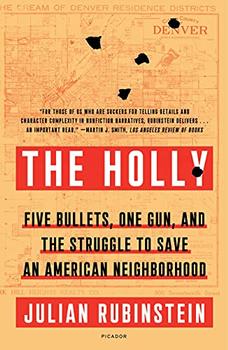Summary | Excerpt | Reviews | Readalikes | Genres & Themes | Author Bio
Five Bullets, One Gun, and the Struggle to Save an American Neighborhood

Critics' Opinion:
Readers' Opinion:
First Published:
May 2021, 400 pages
Paperback:
May 2022, 416 pages
While the federal Fair Housing Act wasn't signed until 1968, Denver's Association of Real Estate Brokers agreed by 1960—more than a decade after Mayor Newton's appeal—to start showing properties in Northeast Park Hill to African Americans. One of the first was Ernestine Boyd.
She was shown a three-bedroom brick house on Pontiac Street. The price was $8,500. She loved it. She and her new husband, Richard, who sold fish at the city markets, had recently started a family. The people Ernestine cooked for helped with the down payment and connected her with a bank. She was approved for a thirty-year mortgage, at $112 per month. At twenty-four years old, a grandchild of slaves, Ernestine was a Denver homeowner.
* * *
NORTHEAST PARK HILL was alluring to Blacks in Denver. Its standalone homes, for sale and rent, had backyards and were walking distance from City Park. But the neighborhood's most distinctive feature was a pair of shopping centers—still a new phenomenon in America—that had opened in the mid-1950s. What was particularly unusual about "The Dahlia" and "The Holly," as they were eventually known, was that they were located not on a busy boulevard but on a narrow neighborhood street—33rd Avenue—five blocks from each other.
The Dahlia, owned by the local businessman Bernard Bernstein, had two strips facing each other across a wide parking lot. Businesses included a Miller supermarket, a tailor, a barbershop, and a bowling alley, the Dahlia Lanes. The Dahlia Lounge offered dinner and dancing, and was where Ernestine occasionally went to meet friends.
The Park Hill Shopping Center, soon renamed the Holly Shopping Center, was owned by Robert J. Main, a former FBI special agent. It had a department store, a dress shop, a pharmacy, and a hardware store. On the east side of the expansive parking lot was a Dar-E-Delight ice cream stand. A separate building on the north side of the square housed a Safeway supermarket.
For the neighborhood's growing number of Black residents, the shopping centers became magnets for their civic and social life. Ernestine could always find a friend in the Holly or the Dahlia to catch up with, or to watch her young daughter, Suzanne. At night, the parking lots became gathering spots for African American youth, who listened to music and danced. Many felt an intense pride in their neighborhood. It was a place unlike any they had experienced.
* * *
AS MORE AFRICAN Americans moved into Northeast Park Hill, Denver's "bold experiment" in racial integration earned Greater Park Hill the nickname "the conscience of the city." President Lyndon Johnson, during a trip to Denver in 1966, directed his motorcade from the airport to stop so he could get out and see it for himself. "It would be difficult to believe that those were Negro homes if you hadn't seen them standing there," Johnson remarked. "When [people] ask 'How can these cities handle some of their problems?' The first thing I would say is, 'Go and see Denver.'"
And yet Denver's mayor, Tom Currigan, who grew up in Park Hill and was with President Johnson that day, knew the neighborhood's reputation was misleading. While the city promoted Park Hill as a "model" of integration, the part of the neighborhood that had been the experiment in integration—Northeast Park Hill—had in fact become one of the nation's most dramatic cases of white flight. Real estate brokers, looking to spur a wave of new sales, warned white residents that the arrival of "Negroes" would begin a downward spiral in home values. One flyer warned that Park Hill was becoming "Dark Hill." Northeast Park Hill, which had been about 98 percent white in 1960, would be about 90 percent Black by decade's end. Its schools were already badly overcrowded, and its unemployment rate was significantly higher than the city's as a whole.
Excerpted from The Holly by Julian Rubinstein. Copyright © 2021 by Julian Rubinstein. Excerpted by permission of Farrar, Straus & Giroux. All rights reserved. No part of this excerpt may be reproduced or reprinted without permission in writing from the publisher.





The Flower Sisters
by Michelle Collins Anderson
From the new Fannie Flagg of the Ozarks, a richly-woven story of family, forgiveness, and reinvention.

The House on Biscayne Bay
by Chanel Cleeton
As death stalks a gothic mansion in Miami, the lives of two women intertwine as the past and present collide.

The Funeral Cryer by Wenyan Lu
Debut novelist Wenyan Lu brings us this witty yet profound story about one woman's midlife reawakening in contemporary rural China.
Your guide toexceptional books
BookBrowse seeks out and recommends the best in contemporary fiction and nonfiction—books that not only engage and entertain but also deepen our understanding of ourselves and the world around us.